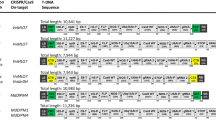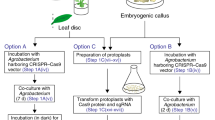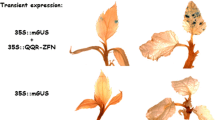Abstract
MultiSite Gateway cloning techniques based on homologous recombination facilitate the combinatorial assembly of basic genetic pieces (i.e., promoters, CDS, and terminators) into gene expression or gene silencing cassettes. pENFRUIT is a collection of MultiSite Triple Gateway Entry vectors dedicated to genetic engineering in fruits. It comprises a number of fruit-operating promoters as well as C-terminal tags adapted to the Gateway standard. In this way, flanking regulatory/labeling sequences can be easily Gateway-assembled with a given gene of interest for its ectopic expression or silencing in fruits. The resulting gene constructs can be analyzed in stable transgenic plants or in transient expression assays, the latter allowing fast testing of the increasing number of combinations arising from MultiSite methodology. A detailed description of the use of MultiSite cloning methodology for the assembly of pENFRUIT elements is presented.
Access this chapter
Tax calculation will be finalised at checkout
Purchases are for personal use only
Similar content being viewed by others
References
Davuluri, G. R., van Tuinen, A., Fraser, P. D., Manfredonia, A., Newman, R., Burgess, D., Brummell, D. A., King, S. R., Palys, J., Uhlig, J., Bramley, P. M., Pennings, H. M., and Bowler, C. (2005) Fruit-specific RNAi-mediated suppression of DET1 enhances carotenoid and flavonoid content in tomatoes. Nat. Biotechnol. 23, 890–895.
Davuluri, G. R., van Tuinen, A., Mustilli, A. C., Manfredonia, A., Newman, R., Burgess, D., Brummell, D. A., King, S. R., Palys, J., Uhlig, J., Pennings, H. M., and Bowler, C. (2004) Manipulation of DET1 expression in tomato results in photomorphogenic phenotypes caused by post-transcriptional gene silencing. Plant J. 40, 344–354.
Van Haaren, M. J. and Houck, C. M. (1993) A functional map of the fruit-specific promoter of the tomato 2A11 gene. Plant Mol. Biol. 21, 625–640.
Hartley, J. L., Temple, G. F., and Brasch, M. A. (2000) DNA cloning using in vitro site-specific recombination. Genome Res. 10, 1788–1795.
Curtis, M. D., and Grossniklaus, U. (2003) A gateway cloning vector set for high-throughput functional analysis of genes in planta. Plant Physiol. 133, 462–469.
Karimi, M., Bleys, A., Vanderhaeghen, R., and Hilson, P. (2007) Building blocks for plant gene assembly. Plant Physiol. 145, 1183–1191.
Karimi, M., Inze, D., and Depicker, A. (2002) GATEWAY™ vectors for Agrobacterium-mediated plant transformation. Trends Plant Sci. 7, 193–195.
Estornell, L. H., Orzaez, D., Lopez-Pena, L., Pineda, B., Anton, M. T., Moreno, V., and Granell, A. (2009) A multisite gateway-based toolkit for targeted gene expression and hairpin RNA silencing in tomato fruits. Plant Biotechnol. J. 7, 298–309.
Fernandez, A. I., Viron, N., Alhagdow, M., Karimi, M., Jones, M., Amsellem, Z., Sicard, A., Czerednik, A., Angenent, G., Grierson, D., May, S., Seymour, G., Eshed, Y., Lemaire-Chamley, M., Rothan, C., and Hilson, P. (2009) Flexible tools for gene expression and silencing in tomato. Plant Physiol. 151, 1729–1740.
Sasaki, Y., Sone, T., Yoshida, S., Yahata, K., Hotta, J., Chesnut, J. D., Honda, T., and Imamoto, F. (2004) Evidence for high specificity and efficiency of multiple recombination signals in mixed DNA cloning by the Multisite Gateway system. J. Biotechnol. 107, 233–243.
Orzaez, D., Mirabel, S., Wieland, W. H., and Granell, A. (2006) Agroinjection of tomato fruits. A tool for rapid functional analysis of transgenes directly in fruit. Plant Physiol. 140, 3–11.
Wroblewski, T., Tomczak, A., and Michelmore, R. (2005) Optimization of Agrobacterium-mediated transient assays of gene expression in lettuce, tomato and Arabidopsis. Plant Biotechnol. J. 3, 259–273.
Kapila, J., De Rycke, R., Van Montagu, M., and Angenon, G. (1997) An Agrobacterium-mediated transient gene expression system for intact leaves. Plant Sci. 122, 101–108.
Twyman, R. M., Stoger, E., Schillberg, S., Christou, P., and Fischer, R. (2003) Molecular farming in plants: host systems and expression technology. Trends Biotechnol. 21, 570–578.
Ellul, P., Garcia-Sogo, B., Pineda, B., Rios, G., Roig, L. A., and Moreno, V. (2003) The ploidy level of transgenic plants in Agrobacterium-mediated transformation of tomato cotyledons (Lycopersicon esculentum Mill.) is genotype and procedure dependent [corrected]. Theor. Appl. Genet. 106, 231–238.
Deikman, J., Kline, R., and Fischer, R. L. (1992) Organization of ripening and ethylene regulatory regions in a fruit-specific promoter from tomato (Lycopersicon esculentum). Plant Physiol. 100, 2013–2017.
Orzaez, D., Medina, A., Torre, S., Fernandez-Moreno, J. P., Rambla, J. L., Fernandez-Del-Carmen, A., Butelli, E., Martin, C., and Granell, A. (2009) A visual reporter system for virus-induced gene silencing in tomato fruit based on anthocyanin accumulation. Plant Physiol. 150, 1122–1134.
Butelli, E., Titta, L., Giorgio, M., Mock, H. P., Matros, A., Peterek, S., Schijlen, E. G., Hall, R. D., Bovy, A. G., Luo, J., and Martin, C. (2008) Enrichment of tomato fruit with health-promoting anthocyanins by expression of select transcription factors. Nat. Biotechnol. 26, 1301–1308.
Ossowski, S., Schwab, R., and Weigel, D. (2008) Gene silencing in plants using artificial microRNAs and other small RNAs. Plant J. 53, 674–690.
Wesley, S. V., Helliwell, C. A., Smith, N. A., Wang, M. B., Rouse, D. T., Liu, Q., Gooding, P. S., Singh, S. P., Abbott, D., Stoutjesdijk, P. A., Robinson, S. P., Gleave, A. P., Green, A. G., and Waterhouse, P. M. (2001) Construct design for efficient, effective and high-throughput gene silencing in plants. Plant J. 27, 581–590.
Voinnet, O., Rivas, S., Mestre, P., and Baulcombe, D. (2003) An enhanced transient expression system in plants based on suppression of gene silencing by the p19 protein of tomato bushy stunt virus. Plant J. 33, 949–956.
Acknowledgments
We wish to thank Paco Timoner for his help in the improvement of tomato agroinjection technique and his good advice, Asun Fernandez for sharing information on tomato introns, and Rafael Martínez for skilled nursing of tomato plants. This work was supported by the Spanish Ministry of Science and Education (Ramón y Cajal program, BIO2010-15384 and BIO2008-03434 projects), the European Commission (program I3P and EU-SOL project), and Fundación Genoma España (ESP-SOL project).
Author information
Authors and Affiliations
Corresponding author
Editor information
Editors and Affiliations
Rights and permissions
Copyright information
© 2012 Springer Science+Business Media, LLC
About this protocol
Cite this protocol
Estornell, L.H., Granell, A., Orzaez, D. (2012). Exploiting MultiSite Gateway and pENFRUIT Plasmid Collection for Fruit Genetic Engineering. In: Dunwell, J., Wetten, A. (eds) Transgenic Plants. Methods in Molecular Biology, vol 847. Humana Press. https://doi.org/10.1007/978-1-61779-558-9_28
Download citation
DOI: https://doi.org/10.1007/978-1-61779-558-9_28
Published:
Publisher Name: Humana Press
Print ISBN: 978-1-61779-557-2
Online ISBN: 978-1-61779-558-9
eBook Packages: Springer Protocols




